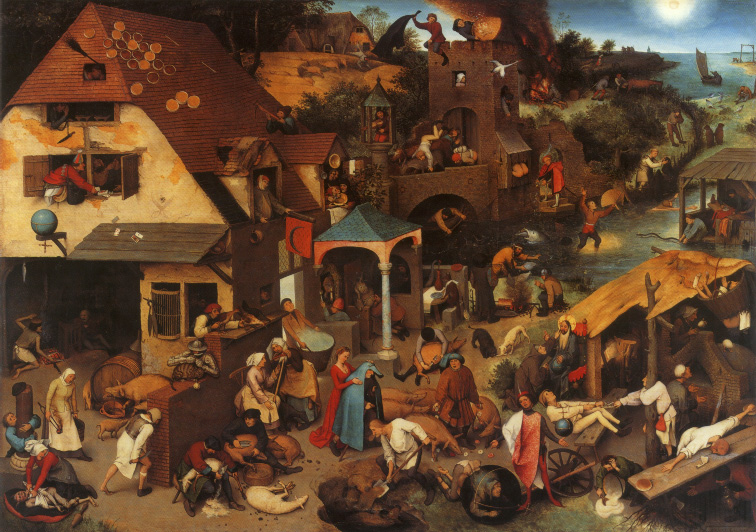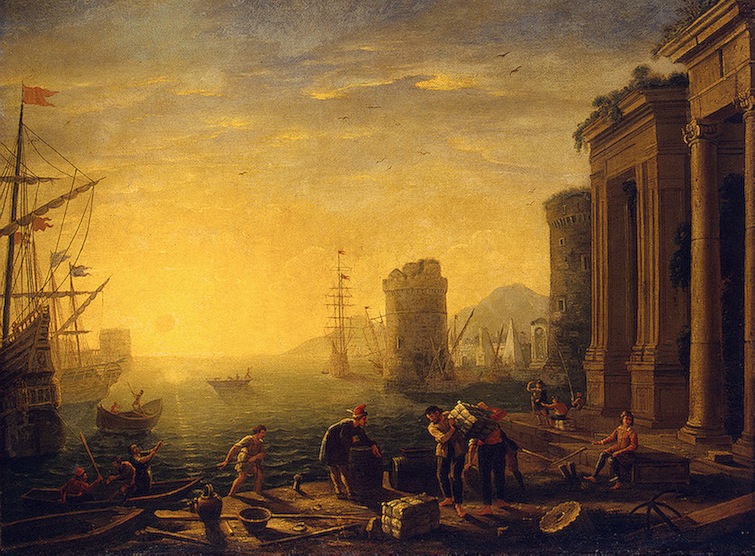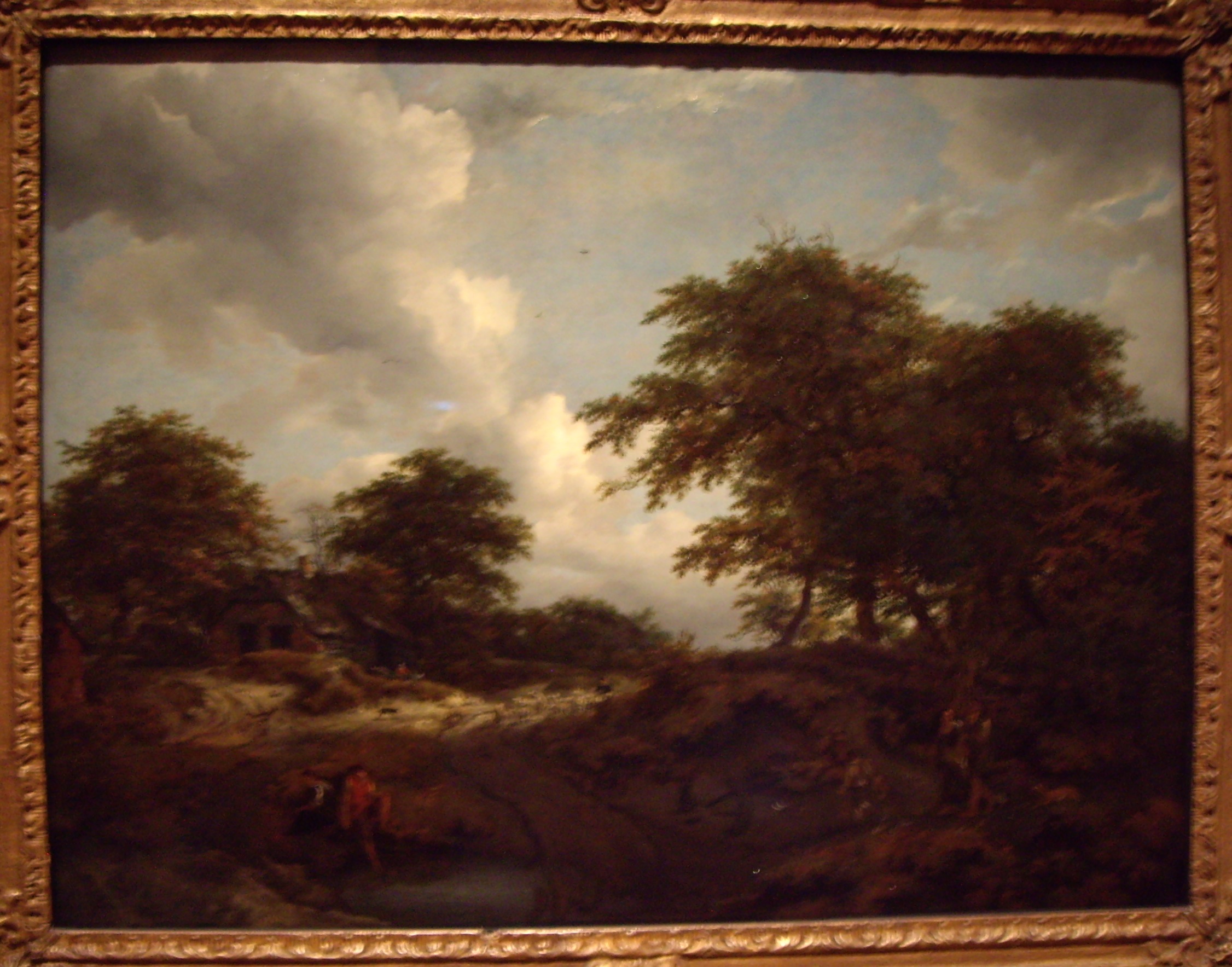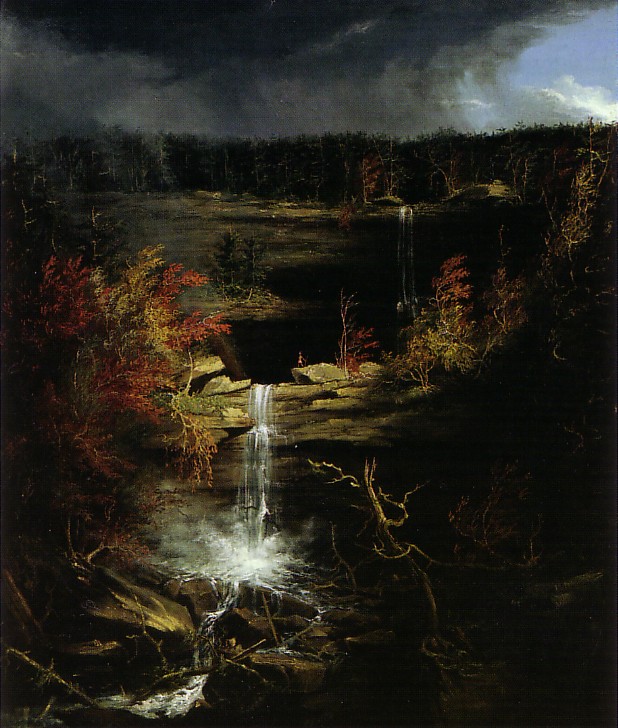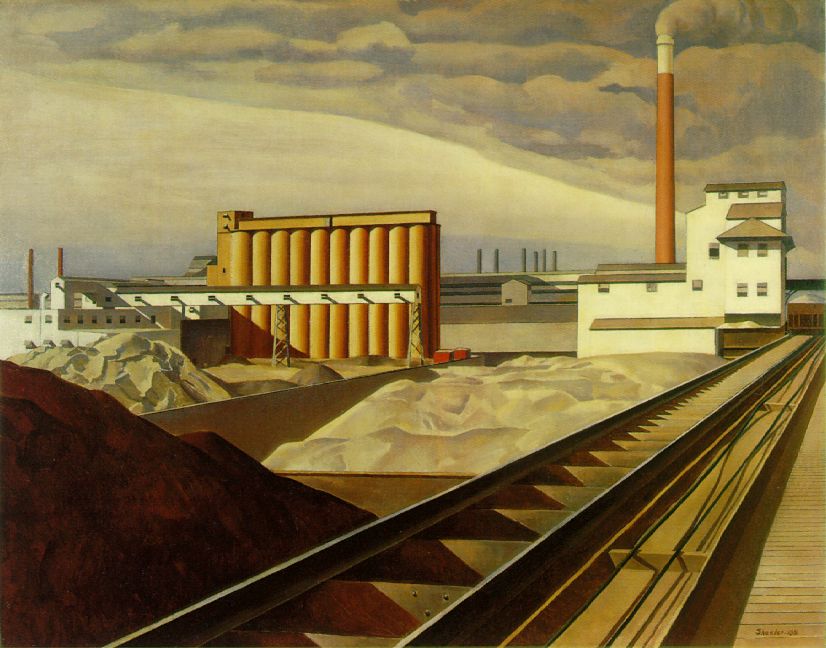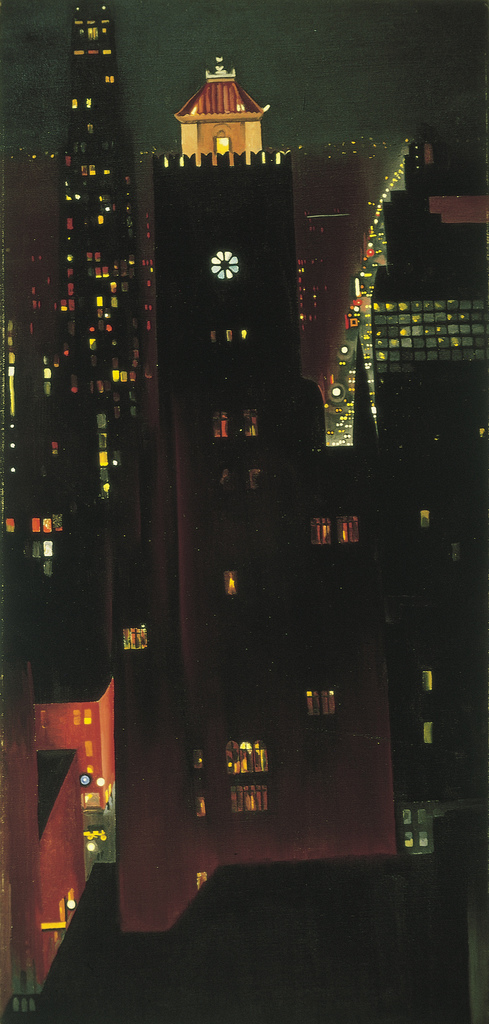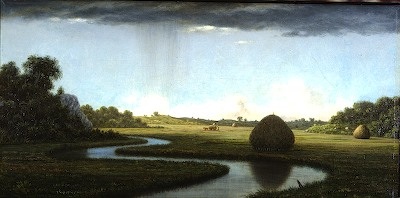 Landscape Art
Landscape Art 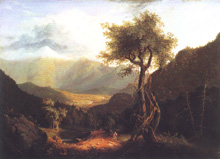
Three Hundred years of changing landscapes as evidence of altered sensibility with regard to picturesque qualities of scenery and transforming the terrain is revealed in paintings.
Three centuries separate Claude Gelleé from Thomas Cole, each of whom captured the imagination of their respective patrons through artistic portrayal of landscape. Three hundred and seventy year separarte the Elder Bruegel and Georgia O'keefe or George Sheeler whose paintings depict the scale of changes.
Chronology | Pieter Bruegel the Elder | Claude Lorrain | Thomas Cole | George Sheeler | Martin Johnson Heade | Commentary | Seashore
Pieter Bruegel the Elder, Netherlandish Proverbs, 1559: "allegories of a foolish and sinful world."
Because of his interest in depicting the peasant in their characteristic settings, Pieter Bruegel the Elder set a new standard for both proper artistic subjects and the manner of expression because he reveals in his mature work the the union of people in nature, during northern Europe's commercial revolution and urbanization. Art critics have suggested that "Well into the 17th century, however, almost all Flemish painters, including Peter Paul Rubens, were indebted to Bruegel's vision of the landscape."
Claude Lorrain and the re-envisioning of Europe's landscapes.
Morning in the Harbor, late 1630s
Oil on canvas, 29 1/8 x 38 3/16 inches or (74 x 97 cm).
Guggenheim Hermitage MuseumClaude's oil paintings exhibit a rare beauty; his fantastic landscapes are bathed in sunlight and haze. His goal, and the goal of other landscape artists of his day, was not to depict nature as they saw it but to treat it in an idealized manner. Although some painters like Pieter Bruegel the Elder painted composite landscapes in order to study and depict natural conditions, unlike Claude. Bruegel did sketches and several such landscapes of the Alps in his youth that are now lost. These earlier portrayals affected a more realistic depiction of landscapes in his later paintings. Claude, however, chose elements of landscape that would relate to each other according to principles of clarity and order.
Shepherd at sunrise, Claude le Lorrain, 1630s.
Claude Gelleé, called Claude Lorrain, circa 1602-1682, French Baroque Era Painter.
Although he was born in the Duchy of Lorraine and spent his entire maturity in Rome, Claude is considered, along with Nicholas Poussin, one of the two founders of the French school of landscape painting. He also made a body of prints, their subjects, for the most part, parallel to those of his paintings: pastoral, biblical, and historical themes set in expansive, light-filled landscapes. His paintings were picturesque, not sublime. The castles and ruins were of special importance. They humanized the landscapes, making them more worthy of aesthetic appreciation because people had selected such places to create recognizable landmarks.
Claude's painting became associated with picturesque travel. Over the course of the following decade he became the most famous landscape artist of his time. His depictions of seaports at sunrise or sunset were appreciated throughout Europe. To avoid imitations of his work, he sketched all his compositions into a sketchbook, and these were later made into engravings that were bound as Liber Veritatis (Book of Truth).
While traveling, people noticed real landscapes that reminded them of Claude paintings - landscapes that were "picturesquely beautiful," pretty enough to be Claude paintings. Ideal landscapes, composed pieces of scenery – filled with light and inspired by the poets of antiquity and bucolic poetry – are also characteristic of a further artistic movement, of which Claude Lorrain is considered the primary representative.
Impact of Claude Lorrain
"In the record of western culture there is nothing to compare with this vogue for landscape that arose in this period."
p. 88
"They often carried Claude (Lorraine) glasses, pieces of tinted, framed glass with handles . . . . the significant fact is that the glass helped to create a pastoral illusion."
"images of perfect harmony between man and nature . . . as if he knew that this perfection could last no longer than the moment in which it takes possession of our minds."
p. 89 Marx, Machine
Seaport at Sunset, 1639
For the first time in the history of art, Claude represented the sun in his works as the source of light. In Seaport at Sunset, the sun dominates the air and colors the ships and buildings. Claude treated light with an unparalleled subtlety which was not surpassed until the Impressionist era. His use of light, space, and atmospheric tones left their mark on all subsequent landscape painting up to the 20th century.
Essay
“A fitting artistic subject; the idealized terrain”
by
Joseph SiryClaude Gelleé was a painter of visions, trained in Rome where he spent most of his life.
He captured a mood among the very affluent mercantile bourgeois classes.
"
He was one of very few seventeenth-century artists who painted only landscapes and his innovative manner and consummate technique contributed to the acceptance of pure landscape as a serious art form." Before this time, the accepted subjects of artists was either portraits or still life used to express the talent and memorialized settings of the objects portrayed in the paintings. Only among the Chinese, did the exclusive focus on terrains and human structures in those settings capture the imagination of painters and patrons alike.
One key to his success is that he created an idealized interpretation of the countryside around Rome and imbued his landscapes with references to the much idolized antique. This is epitomized here in the portrayal of the Temple of Vesta at Tivoli, which was one of the best known and most dramatically sited of all the surviving antique monuments of Rome and the Campagna. The site of any temple, let alone this one is by tradition a setting aside of sacred ground for the purposes of some transcendent value associated with a deity or divine guardian of the terrain.
Claude – after Nicholas Poussin – has given this work strong Arcadian overtones; Arcadia being the ancient idealized location of pastures and woods associated with many ancient gods and goddesses.
The key relationship in this work is the emblematic classical temple painted within the fanciful landscape bathed in golden light. Claude includes a shepherd playing a flute, thus aligning landscape with music and harmony, alluding also to the gods Apollo and Pan, ancient gods with musical attributes. According to legend, Arcadia was the birthplace of Pan and he was the wild manifestation in the form of half animal and half human of untamed places.
Paintings of Claude Gelleé Le Lorrain
America
Thomas Cole, 1801-1848.
Map of Cole's landscape scenes, in upstate New York.
He took to the wild limited only by his education and training yet in his exhibition of his craft he elevated the absence of people in the landscape into a national icon of unsurpassed reverence. Cole inspired numerous painters to capture the scope, color and texture of the national terrain's admirably varied contours. At seventeen his family with him emigrated from England to the United States where in 1825 he moved to New York City and practiced his painting that he largely learned from itinerant artists while living in Ohio and Pennsylvania. His capacity to express the wilder facets of American scenery caught the attention of the American Revolutionary artist John Trumbull who introduced him to Asher B. Durand in the 1820s.Trumbull who bought the painting shown below for $25 had painted numerous significant historical subjects including George Washington, John Adams, John Jay, and Alexander Hamilton, and incidents such as the signing of the Declaration of Independence and the surrender of Lord Cornwallis at Yorktown. Trumbull's own landscapes were not of the scope or detail of Thomas Cole, whom he admired.
Falls of the Kaaterskill, 1826 in the northern Catskill Mountains: Oil on canvas.
Thomas Cole was among the earliest painters to emphasize the wildness and to place the epic story of two centuries of American settlement into a classical historical and religious context. William Cullen Bryant mourned Cole's death from pleurisy in 1848 calling him a "great master of art."
The Metropolitan Museum of Art.
"In the fall of 1825, Cole travelled on a steamship up the Hudson and Erie Canal. Cole was the first to paint landscapes of this area of river surrounded by the Catskill Mountains of New York State. Later in 1925 the New York Evening Post reviewed Cole's work. The English born artist Cole's close friend, Asher Durand, became a prominent figure in the school as well, particularly when the banknote-engraving business evaporated in the Panic of 1837."
"The Hudson River School Mid-19th Century American Art," The Art Expert
The big transformation of landscape by mechanization and urbanism.
Industrialization in the United States from the 1820s until the 1920s, as had occurred earlier in western Europe, completely altered the scale, constituent elements in the landscape fabric, and natural resources of the country. These alterations both confined and extensive were often captured in photographs or as depicted by artists in the landscape painting. Especially from the works of Alfred Stieglitz, Georgia O'Keeffe, Edward Hopper, and George Sheeler [below from the 1931 painting] the sense of a new aesthetic is emerging in step with the neo-industrially sustained landscapes of both cities and the countryside. This painting by Sheeler suggests the the scale of the industrial landscape has completely transformed the agrarian and urban geography in both size and imposing countenance on the terrain. But there is an intonation of ancient Greek columns in the rows of grain silos and a deliberate portrayal of Renaissance perspective in this depiction of the empty railway track with it's contemporary contrasting alignment with both the smokestacks and metal cross-ties (sleepers) between the iron rails.
"In the Classic Landscape, the factory appears to be empty and lonely in the sunset. The railway across the land plays the same role of the waterfront in American Landscape. [1930] The light brown chimney is still there dividing up the sky. "
"the rhetoric of the technological sublime."
Leo Marx, p. 195.
George Sheeler, Classic Landscape, 1931. Oil on canvas.
The sophistication and vertical perspective applied to urbane shapes emerging out of the civic darkness by Georgia O'Keeffe are indicative of the intrusion of electrified cities into the national imagination. As of the 1920 Census half the country then lived in urban areas. The verticality here contrasts nicely with Sheeler's classical horizontal spreading of clear geometrical forms characteristic of the new industrial impacts on the terrain from the expanses of warehouses, silos, and machinery.Georgia O'Keeffe, New York at Night, 1928-29, oil on canvas.
1517, The Reformation
1522, Magellan's voyage proves the Earth is a sphere; the "Circumnavigator's Paradox."
1530, publication of the "Wittenberg World Map,"
1543, Copernicus "revolutionizes" ideas with a sun centered solar system.
1553-55, Pieter the elder Bruegel goes to Italy & returns from Florence to Antwerp via the Alps.
1565, Counter-reformation began in Rome with art patronage as a consequence.
1569, Gerhardus Mercator's earliest revised map of the known Earth.
1582, Pope Gregory declared a reform Calendar on October 4, is changed to 11.
1609, Kepler's Laws of Planetary Motion, two of the three published in Astronomia Nova.
1616, Discovery of Australia by the Dutch East India Company.
1618, Start of the Thirty Years War in Europe.
1619, House of Burgesses meets in Virginia Colony.1620, Sir Francis Bacon publishes The New Atlantis.
1625, Claude Gelleé resided in Rome.
1633, Trial of Galileo in the Vatican for heresy.
1639, 1st observation of transit of Venus by Jeremiah Horrocks & William Crabtree [November 24th] by European astronomers.
1646, The Invisible College founded by English thinkers.
1648, Treaty of Westphalia ends the 30 Years War.
1648-49, Theatrum orbis terrarum, 2 volumes published by Willem Janszoon Blaeu.
1660, Restoration of the Stuart Monarchy in England.
1665, Vermeer paints "Artists' Studio."
1687, Newton publishes the Principia.
1702-13, Queen Anne's War. (The War of Spanish Succession)1720, The Great South Sea Bubble brings financial collapse to Europe.
1730, Newcomen steam engine devised to pump water from mines.
1748, Diderot publishes the Encyclopedia's first volumes.
1756, Start of the Seven Years War in Europe, Asia, & Americas.
1766 The Duchy of Lorraine is ceded to France.
1790, LAVOISIER’S Elements of Chemistry published.
1799-1804, Alexander von Humboldt traveled from Germany to the Americas.
1848, a year of widespread revolutions are suppressed throughout Europe.
1871, Franco-Prussian War & the fall of the Second Empire replaced by Third French Republic.
1886, The Treaty of Berlin partitions the colonial world among European imperialist nations.
1909, Futurist Manifesto of Marinetti.
1914-1918, The Great War (First World War).
1919, The Treaty of Versailles partitions the colonial world among the Allies.
1929, The Great Crash lead to a prolonged Depression, or economic collapse until 1940.
1934, German re-occupaton of the Rhineland in defiance of the Treaty of Versailles.The artists, poets, and writers of early America sensed something unusually significant about the grasslandscapes throughout the expanses that were – and in some regions remain today – periodically submerged by the sea.
Along the extensive coastal marshlands in the drowned river mouths, called estuaries since Roman times, beats a pulse of life so enduring and sublime that both Egyptian and Sumerian observers five thousand years ago sensed reemergence as the embodied spirits of these wetlands. They were seen then in the Old Kingdom and in Mesopotamia as restorative sources of abundance.
Alternately wet and dry these intricate waterways filled with fish, birds and animals inspired these writers to express the ineffable quality of tidal wetlands that seemingly give birth to land and seeds from the unremarkable mud of the Earth. As if by some liquid magic, life appears in and emerges out of the alluvium annually, if not monthly or seasonally, and in so doing inspired both lasting themes of creation or human origins and the promise of resurrection for all time to come. The artists who painted marsh-lined shorelines, captured in some more tangible manner, the glory and the power of these ephemeral places neither truly land, yet neither fully water. They are the paradox of place incarnate, at once, coastal wetlands are the precipitate of the waters, and fluid origins of extensive grasslands and forests astride these rising seas.
Sources Seaside study guide Claude Lorrain | Thomas Cole | George Sheeler Martin Johnson Heade, Newburyport Marshes: Passing Storm, c.1865/70. Bowdoin College Museum of Art, Maine.
Martin J. Heade 1819-1904, was an American painter who was one of the landscape artists who joined a group called the "luminists" for their attention to the details of light falling on expansive wetland terrains and native features of the forests and shores.

.gif)



